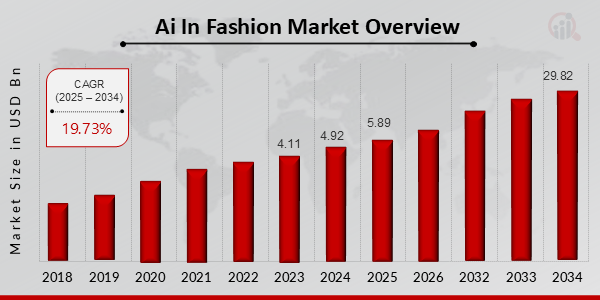Ai In Fashion Market Overview
Ai In Fashion Market is projected to grow from USD 5.89 Billion in 2025 to USD 29.82 Billion by 2034, exhibiting a compound annual growth rate (CAGR) of 19.73% during the forecast period (2025 - 2034). Additionally, the market size for Ai In Fashion Market was valued at USD 4.92 billion in 2024.
Key AI in Fashion Market Trends Highlighted
The AI in Fashion Market is being significantly influenced by several key market drivers, including the increasing demand for personalization and customization in consumer experiences. As brands strive to enhance customer engagement, the integration of AI technologies facilitates tailored shopping experiences, enabling companies to recommend products that align closely with individual preferences. The rapid advancement of machine learning algorithms is empowering fashion retailers to analyze vast amounts of consumer data effectively, predicting trends and optimizing inventory management, thereby enhancing operational efficiencies.
In terms of opportunities, there is a growing potential for AI-powered virtual fitting rooms and augmented reality applications, which not only improve the online shopping experience but also reduce return rates. Additionally, the increasing emphasis on sustainability and ethical practices allows companies to explore innovative applications of AI in optimizing production processes and supply chains, thereby minimizing waste and promoting eco-friendly practices.
Recent trends indicate a concerted effort among fashion brands to leverage AI for enhancing design innovation and trend forecasting. Collaborations between technology firms and fashion houses are becoming more prevalent, leading to the development of intelligent design tools that assist in predicting seasonal styles based on data-driven insights. Furthermore, the rise of social media and influencer marketing is intertwining with AI to analyze consumer sentiment, enabling brands to create more responsive marketing strategies. Overall, the fusion of artificial intelligence with the fashion industry is paving the way for a dynamic and transformative future driven by data-centric insights and innovative consumer engagement strategies.
Figure1: Ai In Fashion Market Overview (2025-2034)

Source: Primary Research, Secondary Research, MRFR Database and Analyst Review
Ai In Fashion Market Drivers
Rising Demand for Personalization and Customer Experience
The AI in Fashion Market Industry is experiencing a significant shift towards personalization as consumers increasingly seek unique and tailored shopping experiences. This demand is primarily driven by the advancements in AI technology, which enables brands to analyze consumer behavior, preferences, and purchasing patterns in real-time. As a result, fashion companies can create customized recommendations, personalized marketing messages and bespoke product offerings that resonate with individual customers.This level of personalization enhances customer satisfaction and loyalty, ultimately leading to increased sales and a stronger market presence. Moreover, integrating AI into fashion retail helps streamline the shopping experience, making it more engaging and efficient. The ability to predict trends and understand consumer preferences allows brands to stay ahead in an ever-evolving industry. As the market continues to grow, the call for enhanced personalization will further amplify the role of AI, making it a pivotal component in the success of fashion brands.The infusion of AI-driven solutions to offer key operational areas such as supply chain management, design optimization, and marketing strategies also helps brands maintain the edge they need to thrive in a competitive landscape.
Efficient Supply Chain Management and Operational Optimization
Within the AI In Fashion Market Industry, efficient supply chain management has become a critical driver of growth. AI technologies enable brands to optimize inventory management, forecast demand accurately and minimize lead times. By leveraging AI analytics, fashion companies can make informed decisions regarding production and distribution, ensuring that the right products reach consumers at the right time. This ultimately reduces costs and enhances profitability, making businesses more competitive in a crowded market.Furthermore, with AI algorithms analyzing data from various sources, brands can respond swiftly to market trends and consumer demands, strengthening their operational capabilities and fostering a more agile approach to fashion retail.
Growing Investment in AI Technologies
The rise of investment in AI technologies is propelling the AI in Fashion Market Industry toward an unprecedented level of sophistication and capability. Fashion companies and startups are increasingly dedicating resources toward harnessing the power of AI, which facilitates the automation of tedious processes, enhances the creativity of design and improves customer interaction. As AI tools become more accessible, organizations are adopting them to drive efficiency and innovation across various functions product: design, marketing, sales and customer service.This heightened focus on AI adoption signifies a shift in the fashion industry as companies recognize the transformative potential of these technologies in shaping future operations and customer relationships.
AI in Fashion Market Segment Insights
AI in Fashion Market Application Insights
The AI in Fashion Market is projected to possess a robust growth trajectory, as evidenced by its valuation of 3.43 USD Billion in 2023, expected to rise substantially in the coming years. The market's Applications collectively drive innovation and efficiency within the fashion industry, with various segments addressing unique consumer needs and operational demands. Amongst these, Design Assistance plays a pivotal role, valued at 1.02 USD Billion in 2023 and anticipated to grow to 5.12 USD Billion by 2032, as designers increasingly leverage AI tools to enhance creativity and streamline their design processes, contributing significantly to the market growth.
The Personalized Shopping Experience segment is another important area, holding a valuation of 0.89 USD Billion in 2023 and is expected to expand to 4.48 USD Billion by 2032. This segment enhances customer engagement through tailored recommendations and personalized interactions, addressing the modern consumer's desire for individualized experiences in the competitive fashion retail landscape. Supply Chain Management, valued at 0.68 USD Billion in 2023 and projected to reach 3.4 USD Billion in 2032, showcases the vital role of AI in optimizing inventory management, demand forecasting, and logistics, ensuring that fashion brands can respond swiftly to market changes and consumer preferences.
Trend Forecasting is also essential, starting with a valuation of 0.54 USD Billion in 2023 and aiming for 2.67 USD Billion by 2032, as the fashion industry increasingly relies on data analysis to predict emerging trends, providing stakeholders with insights that can significantly influence product development and marketing strategies. Visual Search, though starting from a lower base with a valuation of 0.3 USD Billion in 2023, is projected to grow to 1.69 USD Billion in 2032. This segment has gained traction by allowing consumers to find products through images rather than text, revolutionizing the online shopping experience and driving sales by improving discoverability.
Each of these segments contributes distinctly to the market's overall dynamics, revealing how AI technologies reshape fashion industry practices. The combination of efficiency improvements, enhanced customer experiences, and data-driven decision-making is expected to propel the AI in Fashion Market revenue upward. In terms of market growth, certain segments are well-positioned for significant advances due to rising consumer expectations, increased competition and technological advancements, all underlining the importance of AI’s role in modernizing and transforming the fashion sector.
The comprehensive landscape of the AI in Fashion Market segmentation is thus characterized by diverse applications, all of which highlight the ongoing evolution influenced by machine learning and artificial intelligence technologies.
Figure2: AI in Fashion Market, By Application, 2023 & 2032 (USD billion)

Source: Primary Research, Secondary Research, MRFR Database and Analyst Review
AI in Fashion Market Deployment Mode Insights
The AI in Fashion Market, focusing on Deployment Mode, has showcased significant growth opportunities driven by technological advancements and increasing demand for personalization within the industry. As of 2023, this segment is witnessing notable traction, driven primarily by the adoption of Cloud-Based solutions, which offer flexibility and scalability to businesses seeking to enhance customer experiences. On-premises solutions also play a crucial role, providing organizations with greater control over their data and security, catering especially to large fashion enterprises.The rising trend towards digital transformation and integration of AI technologies in designing merchandising, and supply chain management have further fueled the overall market dynamics. The AI in Fashion Market statistics highlight that a balanced distribution is evident, with Cloud-Based models dominating due to their lower upfront costs and access to real-time analytics. Meanwhile, the On-Premises approach remains significant for fashion brands prioritizing data security and customized applications. The growth drivers in this segment encompass the need for data-driven decision-making and enhanced operational efficiencies, although challenges like integration complexity and cost remain present.
AI in Fashion Market Component Insights
This segment is crucial as it underpins the technological advancements that drive innovation in the fashion industry, enhancing areas such as personalized shopping experiences and supply chain optimization. The Software aspect is vital, providing tools that leverage AI to analyze trends and consumer behavior efficiently, while the Services element focuses on the implementation and management of these AI technologies, ensuring businesses can effectively integrate them into their operations.The ongoing digital transformation and increased demand for data-driven insights are contributing factors that significantly impact the AI in Fashion Market statistics by expanding the use of AI technologies. With a focus on improving operational efficiency and customer engagement, the Components segment plays an essential role in the market's development and overall dynamics.
AI in Fashion Market End User Insights
Retailers are leveraging AI to enhance inventory management, optimize supply chains and improve customer experiences, positioning themselves as key players in this market. Similarly, Brands utilize artificial intelligence to strengthen marketing strategies, personalize consumer interactions, and predict fashion trends, thus significantly impacting market dynamics.Consumer Marketplaces dominate by offering a wide range of options to consumers, enhancing user experience through data-driven recommendations. Fashion Designers harness AI for design innovations and trend forecasting, allowing them to create unique offerings that resonate with changing consumer preferences. This comprehensive approach highlights the importance of each segment in contributing to the broader AI in Fashion Market revenue stream, reflecting the integration of AI technologies that drive efficiency and creativity across the industry.Overall, the AI in Fashion Market segmentation showcases a landscape where AI adoption empowers various stakeholders to maximize their growth potential amidst evolving market demands.
AI in Fashion Market Technology Insights
Within the technology segment, various components contribute to the overall market development. Machine Learning is increasingly used for predictive analytics and trend forecasting, enabling fashion brands to make data-driven decisions. Natural Language Processing aids customer interactions by providing tailored recommendations and improving sentiment analysis, thus enhancing user experience.
Computer Vision plays a crucial role in visual search and inventory management, streamlining operations in the fashion industry. Meanwhile, Recommendation Systems are significant as they create personalized shopping experiences, influencing purchasing behavior and increasing customer loyalty. The AI in Fashion Market data indicates a strong adoption of these technologies, with enterprises continuously investing in innovative solutions to stay competitive in this evolving landscape. Overall, the AI in Fashion Market statistics reflect the transformative impact of technology in reshaping the fashion industry and driving market growth.
AI in Fashion Market Regional Insights
North America holds a majority share with a valuation of 1.36 USD Billion, driven by technological advancements and strong consumer demand for personalized shopping experiences. Europe follows closely at 0.9 USD Billion, benefiting from a robust fashion industry and innovative AI implementations. The Asia Pacific region shows significant potential with 0.95 USD Billion, as the region increasingly adopts AI capabilities to enhance retail operations.The Middle East and Africa, while currently valued at 0.1 USD Billion, is expected to witness substantial growth to 0.5 USD Billion by 2032, reflecting rising investments in technology. South America remains the smallest segment, valued at 0.12 USD Billion, but is indicative of potential future growth opportunities. These regional dynamics highlight the importance of specific market trends and the competitive landscape, driven by factors such as consumer preferences and technological integration in the fashion sector, ensuring the relevance of AI in Fashion Market statistics for stakeholders seeking to navigate this evolving industry landscape.
Figure3: AI in Fashion Market, By Regional, 2023 & 2032 (USD billion)

Source: Primary Research, Secondary Research, MRFR Database and Analyst Review
Ai In Fashion Market Key Players And Competitive Insights
The AI in Fashion Market is experiencing rapid growth due to the increasing integration of artificial intelligence technologies across various facets of the fashion industry. Competitive insights into this market reveal a landscape characterized by innovation, collaboration and the relentless pursuit of enhancing consumer experiences. Companies are leveraging advanced algorithms, machine learning, and data analytics to improve everything from design and inventory management to personalized shopping experiences. As AI continues to evolve, it enables fashion brands to automate processes, optimize supply chains, and create highly tailored marketing strategies.
This competitive environment is driving companies to differentiate themselves through unique offerings and technological advancements, shaping the future of fashion in a digital age.Vue.ai stands out as a formidable player in the AI in Fashion Market, primarily due to its robust technological capabilities and focus on retail optimization through AI-driven solutions. The company's strength lies in its comprehensive suite of products that automate and enhance various aspects of the fashion retail process. From visual search capabilities to personalized product recommendations, Vue.ai empowers retailers to improve customer engagement and conversion rates.
Additionally, their capabilities in inventory management and trend forecasting enable brands to make data-informed decisions, significantly reducing excess stock and increasing operational efficiencies. Vue.ai's innovative approach not only enhances the shopping experience for consumers but also drives profitability for retailers, solidifying its position as a leader in this rapidly evolving market.Uniqlo has established itself as a key player in the AI in Fashion Market by effectively utilizing AI technologies to enrich its retail ecosystem.
The company's emphasis on customer-centric experiences has driven it to adopt AI solutions that enhance personal shopping and streamline inventory processes. Uniqlo's strengths include its ability to analyze consumer data to understand preferences and trends, leading to more effective product offerings that align with customer needs. Furthermore, its integration of AI in supply chain management ensures optimized operations and rapid responsiveness to market demands. Uniqlo’s commitment to innovation, combined with its strategic use of AI, reinforces its strong market presence and ability to adapt to the competitive landscape of fashion retail, positioning it for continued success in the AI-driven future of the industry.
Key Companies in the Ai In Fashion Market Include
-
Vue.ai
-
Uniqlo
-
Designhill
-
Adobe
-
Alibaba
-
Google
-
SAP
-
Stitch Fix
-
H
-
IBM
-
Zalando
-
Heuristix
-
Microsoft
-
Amazon
-
Shopify
Ai In Fashion Market Industry Developments
Recent developments in the AI in Fashion Market have showcased a profound integration of technology with the apparel industry. Major fashion brands are increasingly adopting AI-driven tools to streamline their supply chains, enhance customer experiences, and personalize shopping journeys. Collaborations between tech companies and fashion houses are becoming more prevalent, allowing for innovative solutions in areas such as virtual fitting rooms and inventory management. Significant investments in AI technology are being directed toward data analytics, enabling brands to predict trends and optimize pricing strategies more effectively.
Furthermore, sustainability is becoming a focal point, with AI being utilized to minimize waste and create eco-friendly production processes. As the market is expected to grow from $3.43 billion in 2024 to $17.36 billion by 2032, the roadmap for AI applications in fashion indicates a shift toward a more digitized and consumer-focused approach. Overall, ongoing advancements in AI technology are likely to reshape traditional business models within the fashion sector, driving both innovation and competitive advantage.
Ai In Fashion Market Segmentation Insights
AI in Fashion Market Application Outlook
- Design Assistance
- Personalized Shopping Experience
- Supply Chain Management
- Trend Forecasting
- Visual Search
AI in Fashion Market Deployment Mode Outlook
AI in Fashion Market Component Outlook
AI in Fashion Market End User Outlook
- Retailers
- Brands
- Consumer Marketplaces
- Fashion Designers
AI in Fashion Market Technology Outlook
- Machine Learning
- Natural Language Processing
- Computer Vision
- Recommendation Systems
AI in Fashion Market Regional Outlook
- North America
- Europe
- South America
- Asia Pacific
- Middle East and Africa
|
Report Attribute/Metric
|
Details
|
|
Market Size 2024
|
4.92 (USD Billion)
|
|
Market Size 2025
|
5.89 (USD Billion)
|
|
Market Size 2034
|
29.82 (USD Billion)
|
|
Compound Annual Growth Rate (CAGR)
|
19.73% (2025 - 2034)
|
|
Report Coverage
|
Revenue Forecast, Competitive Landscape, Growth Factors, and Trends
|
|
Base Year
|
2024
|
|
Market Forecast Period
|
2025 - 2034
|
|
Historical Data
|
2019 - 2023
|
|
Market Forecast Units
|
USD Billion
|
|
Key Companies Profiled
|
Vue.ai, Uniqlo, Designhill, Adobe, Alibaba, Google, SAP, Stitch Fix, H, IBM, Zalando, Heuristix, Microsoft, Amazon, Shopify
|
|
Segments Covered
|
Application, Deployment Mode, Component, End User, Technology, Regional
|
|
Key Market Opportunities
|
Personalized shopping experiences Trend forecasting and analytics Inventory management optimization Sustainable fashion innovations Virtual fitting room technologies
|
|
Key Market Dynamics
|
Increased demand for personalization Enhanced supply chain efficiency AIdriven trend forecasting Improved customer experience Sustainable fashion innovations
|
|
Countries Covered
|
North America, Europe, APAC, South America, MEA
|
Frequently Asked Questions (FAQ) :
By 2032, the Ai In the Fashion Market waexpected to be valued at 29.82 USD Billion.
The expected CAGR for the AI in Fashion Market from 2025 to 2034 is 19.73 percent.
North America is expected to hold the largest share of the Ai In Fashion Market, valued at 6.75 USD Billion by 2032.
The Personalized Shopping Experience application segment is expected to be valued at 4.48 USD Billion by 2032.
Major players in the AI in Fashion Market include companies like Adobe, Alibaba, Microsoft, and Amazon.
The Supply Chain Management application is expected to reach a market size of 3.4 USD Billion by 2032.
The Trend Forecasting application segment is projected to be valued at 2.67 USD Billion by 2032.
In 2023, the Visual Search application segment is valued at 0.3 USD Billion.
In Europe, the AI in Fashion Market is expected to grow to 4.5 USD Billion by 2032.
The Design Assistance application segment is estimated to be valued at 5.12 USD Billion by 2032.
























